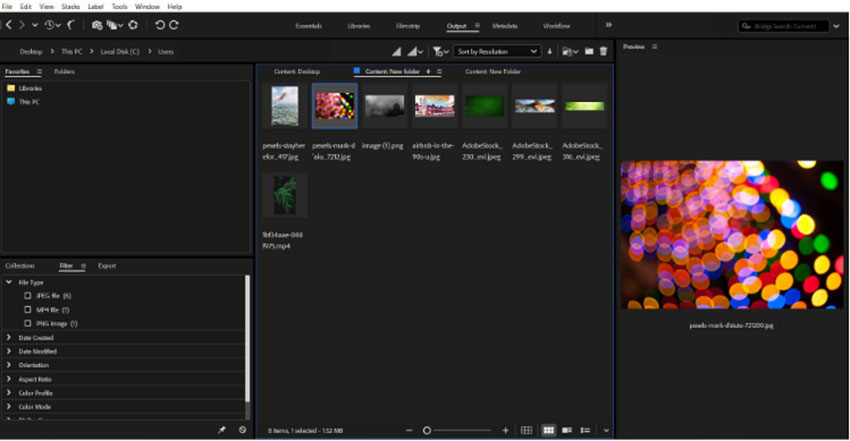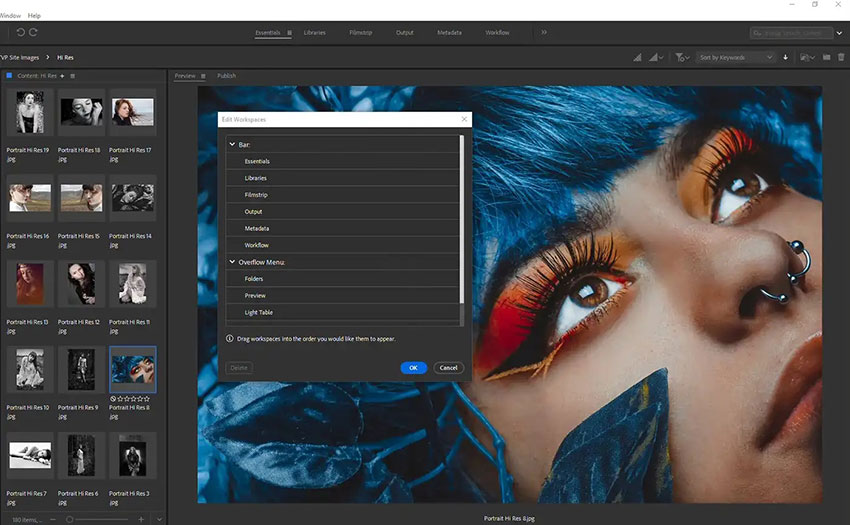Lightroom vs Adobe Bridge: Choosing the Right Tool
Updated on
If you've ever found yourself scrolling through endless threads comparing Adobe Bridge and Lightroom, you're not alone. Many photographers and designers struggle to determine which software best aligns with their workflow. Common questions include whether to use Bridge for image previews before editing in Lightroom, or if Lightroom's catalog system is necessary for effective asset management. This post aims to provide a clear and concise comparison of Lightroom vs Adobe Bridge, helping you make an informed decision.

1. Adobe Bridge vs. Lightroom: User Interface
Adobe Bridge
Adobe Bridge is a versatile digital asset management tool that streamlines the process of organizing and navigating large image collections. Its intuitive interface, characterized by a clean layout and straightforward tools, facilitates rapid navigation and efficient management of files. With Adobe Bridge, users can effortlessly locate specific files, apply metadata tags, and perform organizational tasks, saving valuable time and streamlining creative workflows.
- Simplified interface: The minimalist design focuses on essential functions, reducing clutter and cognitive load.
- Flexible views: a variety of view options, including thumbnail, list, detail views, customizing workspace.
- Metadata editing: comprehensive metadata editing tools to add, edit, and search for keywords, captions, et.
- Batch processing: batch renaming, labeling, and other bulk operations, streamlining repetitive tasks.

Adobe Lightroom
One of Lightroom's standout features is its modular design. This enables photographers to customize their workspace to suit their specific workflow, ensuring maximum efficiency and productivity. By organizing panels and tools in a way that aligns with their creative process, users can streamline their editing tasks and avoid unnecessary distractions.
- Modular design: divide into modules such as Library, Develop, Map, Book, Slideshow, Print, and Web.
- Non-destructive editing: ensure that original image data is preserved, allowing for unlimited adjustments without damaging the original file.
- Advanced editing tools: offer lots of powerful tools for tone adjustments, color correction, and creative effects.
- Catalog system: provide a centralized database for organizing and managing large image collections.

2. Adobe Bridge vs Lightroom: Key Features
Adobe Bridge is a specialized tool for organizing and managing image assets, while Adobe Lightroom is a comprehensive application for both managing and editing photos. The best choice for you depends on your specific needs and workflow. If you prioritize efficient organization and basic editing, Bridge is a great option. If you require advanced editing capabilities and a seamless workflow with Photoshop, Lightroom is the way to go.
Digital Asset Management (DAM)
Adobe Bridge is a specialized digital asset management (DAM) tool designed to efficiently organize, categorize, and search through extensive image libraries. It offers a robust set of features tailored specifically for efficient asset management, including custom metadata fields, smart collections, and efficient batch processing. These features allow users to create personalized organizational systems, automate repetitive tasks, and streamline their workflows.
Adobe Lightroom is a comprehensive photo editing and management software that also incorporates DAM capabilities. While Lightroom's primary focus is on the end-to-end workflow of capturing, editing, and sharing photos, its integrated DAM features provide a solid foundation for organizing and managing digital assets. Lightroom's DAM capabilities are not as extensive as a dedicated DAM tool like Bridge.
Image Editing
Adobe Bridge is primarily a file management tool, designed to streamline the organization and navigation of large image libraries. While it offers some basic editing functions like cropping, resizing, and applying simple adjustments, its primary focus is on tasks such as renaming, labeling, and preparing images for export. Bridge's intuitive interface and efficient search capabilities make it an ideal tool for managing and organizing digital assets.
Adobe Lightroom is a comprehensive image editing application that provides a vast array of tools for photographers to enhance and manipulate their images. From RAW processing to tone adjustments, color grading, and creative effects, Lightroom offers a wide range of features to cater to the needs of professional and amateur photographers alike. One of Lightroom's key strengths is its non-destructive editing workflow, which allows users to apply changes to their images without permanently altering the original data, providing flexibility and freedom to experiment.

Integration with Other Software
Adobe Bridge, as an integral part of the Adobe Creative Suite, seamlessly integrates with other Adobe applications such as Photoshop, Illustrator, and InDesign. This integration allows for efficient workflow management, as users can easily access and organize their assets from a central hub. Bridge's ability to connect with other Adobe tools enhances collaboration and streamlines the creative process.
Adobe Lightroom also integrates seamlessly with Photoshop, offering round-trip editing capabilities. This means that users can edit images in Lightroom, then switch to Photoshop for more advanced manipulations, and seamlessly synchronize changes between the two applications. This integration is particularly beneficial for photographers who require a comprehensive workflow that combines the strengths of both Lightroom and Photoshop.

3. Adobe Bridge vs Lightroom: Core Strengths
Adobe Bridge is a more efficient choice for users who prioritize image management, batch processing, and seamless integration with other Adobe software. Its focus on organizing, categorizing, and searching large image libraries makes it an ideal tool for those who need to manage and access their assets efficiently.
Adobe Lightroom is better suited for users who focus on image editing and post-processing. Its powerful RAW processing capabilities, non-destructive editing workflow, and extensive library of presets and plugins make it an ideal choice for photographers who want to enhance and refine their images.
Adobe Bridge Core Strengths
- Powerful batch processing: batch rename, resize, add watermarks, and other bulk operations.
- Flexible metadata management: customize titles, keywords, author information, and more.
- Seamless integration with other Adobe software: Bridge seamlessly integrates with Photoshop, Illustrator, and other Adobe applications, enabling smooth image transfer and processing.
Adobe Lightroom Core Strengths
- Non-destructive editing: do not alter the original image data, undo or adjust edits at any time.
- Powerful RAW processing: recover more image details and producing higher-quality results.
- Rich preset and plugin ecosystem: a vast collection of presets and plugins, catering to diverse user needs and enabling quick creation of various image styles.

4. Adobe Bridge vs Lightroom: Who Should Use It and When?
Adobe Bridge
Adobe Bridge is a digital asset management tool primarily designed for individuals who deal with large volumes of images. It's particularly useful for:
- Photographers: rename, resize, and apply metadata to multiple images at once.
- Designers: Designers often use Bridge to collect and organize images for their projects.
- Image editors: Professionals who work with images on a daily basis will find Bridge useful for tasks like batch processing and quickly locating specific images.
Common use cases for Adobe Bridge
- Managing large image libraries: organize and categorize your images, making it easy to find specific files.
- Batch processing: for tasks like renaming, resizing, or applying watermarks to multiple images.
- Metadata management: add and edit metadata, such as keywords, captions, and copyright information.
- Integration with other Adobe applications: Bridge seamlessly integrates with other Adobe software like Photoshop and Illustrator, allowing you to quickly move images between applications.

Lightroom
Adobe Lightroom is a more comprehensive tool that combines digital asset management with powerful image editing capabilities. It's a popular choice for:
- Professional photographers: who need to capture, edit, and share their images. It offers a non-destructive editing workflow, allowing users to experiment with different adjustments without damaging the original image.
- Designers: Designers who need to retouch and enhance images for their projects can benefit from Lightroom's versatile editing tools.
Common use cases for Adobe Lightroom
- RAW image editing: Process RAW files for maximum detail and quality.
- Non-destructive editing: Edit without altering original images.
- Creative tools: Enhance images with presets, gradients, and brushes.
- Photo management: Organize and manage your entire photo library.

5. Adobe Lightroom vs Bridge: Price
Adobe Bridge is indeed a free application included with your Adobe Creative Cloud subscription. As part of the subscription, you have access to a suite of creative tools, including Bridge, Lightroom, Photoshop, and more. If you have a Creative Cloud subscription, you should be able to download and use Adobe Bridge for free.
Lightroom offers different pricing tiers. These prices are subject to change, and Adobe may offer additional pricing options or promotions.
- Lightroom for Teams (Full Version) Price: US$37.99 per month per license.
- Lightroom (Individuals) Price: US$9.99 per month.

Conclusion
If you're a beginner or hobbyist looking for a user-friendly photo editor, Lightroom is a great choice. If you're a professional who needs to manage large libraries of images and integrate them with other Adobe applications, Bridge is the better option. For those who need both powerful editing and efficient asset management, combining Bridge and Lightroom is the way to go.